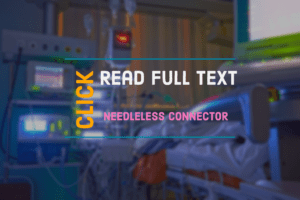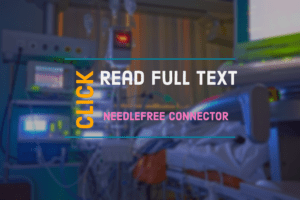Implantable port infection risk

“In many patients with port infection, the ports are removed because antibiotics are ineffective. We evaluated the risk factors associated with port removal due to port infection” Hara et al (2024).
Hemodialysis in patients with superior vena cava syndrome

“Superior vena cava syndrome in hemodialysis patients resulting from previous or current use of a tunneled central vein catheter is a rare but potentially severe condition” D’Amico et al (2024).
Reduction of blood culture contamination rates

“In response to the surge of the Omicron variant, we adjusted our PPE protocol from January 2022. This study aimed to evaluate the impact of the simplified PPE policy on blood culture contamination rates” Park et al (2024).
Isopropanol leakage from antiseptic barrier caps

“Needleless connectors (NCs) can be disinfected using antiseptic barrier caps (ABCs) to reduce the risk of catheter-related bloodstream infections. However, recent evidence suggests that isopropanol can leak from the ABC into the NC, posing concern about their safe use” Boissière et al (2024).
Impact of blood culture contamination on antibiotic use – Full Text

“Blood culture contamination (BCC) has been associated with prolonged antibiotic use (AU) and increased health care utilization; however, this has not been widely reevaluated in the era of increased attention to antibiotic stewardship” Schinkel et al (2023).
Correction of PICC malposition

“US-guidance can help reduce catheter malposition during bedside PICC insertion. Patients with risk factors such as multiple previous central vein insertions, failed peripheral line insertions, left arm insertion, or high BMI should undergo thorough sonographic evaluation of the arm vessels to prevent malposition” Jang et al (2023).
Anticancer drug infusion with disposable pumps

“This study aimed to determine effects of constant infusion with a chemically-driven pump on plasma drug concentrations compared to elastomeric pumps” Lee and Lee (2023).
Needleless connector disinfection procedure – Full Text

“This study aimed to verify the efficacy of disinfection procedures to reduce Acinetobacter baumannii blaOXA-23 bacterial load in needleless connectors that had been experimentally contaminated” Biazus-Dalcin et al (2024).
IV flush solution for peripheral IV catheters in children – Full Text

“To conduct a meta-analysis to evaluate the role of heparin versus normal saline lock in the care of peripheral intravenous catheters” Zhang et al (2024).
CLABSI related complications – Full Text

“This 2-year retrospective single-center study of patients with CRBIs from a tertiary care hospital examined the hematogenous complications associated with CRBIs according to patient characteristics, central venous catheter (CVC) types, and causative bacteria” Carolle Ngo Bell et al (2024).
PICC thrombosis risk factors – Full Text

“Patients with PICC placements have a higher risk of thrombosis, citric acid, blood flow, platelet count and frailty are the main risk factors” Gao et al (2024).
CLABSI criteria in pediatric oncology patients – Full Text

“The aim of this study was to investigate the applicability of the central line-associated bloodstream infection (CLABSI) criteria of the Centers for Disease Control and Prevention in pediatric oncology patients” van den Bosch et al (2024).
Contrast media extravasation study

“Main risk factors for CM extravasation are female, diabetes, venous thrombosis, multi-site angiography, and injection rate ≥ 3 mL/s” Liu et al (2024).
Midline catheters in neonatal intensive care

“The purpose of this article is to present the advantages and disadvantages of MPCs as an alternative approach for venous access in neonates when appropriate” Sykes et al (2024).
Needlestick injury and HIV infection risk – Full Text

“The current CDC recommendations for HIV infection treatment are antiretroviral therapies, such as an HIV postexposure prophylaxis regimen, which consists of a cocktail of antiretrovirals and postexposure prophylaxis immediately for occupational exposures, such as accidental needlestick exposure from an HIV infected patient” Abadie et al (2024).
CVC insertion in patients at increased risk of bleeding

“In this study we demonstrated that the application of the GAVeCeLT suggested bundle can minimize the number of bleeding complications even in patients hospitalized in Internal Medicine Units” Mumoli et al (2024).
Rapid platelet and red cell administration

“Our study suggested that mixing ABO-incompatible platelets with RBCs in a rapid infuser does not induce in vitro hemolysis. These findings support the use of rapid infusers regardless of platelet compatibility in support of hemostatic resuscitation” Jung et al (2024).
Prevention of amiodarone-related phlebitis

“The 15-min cold application was found to be effective in terms of the rate of phlebitis development, phlebitis grade and time of phlebitis development” Okyay and Basak (2024).
Pediatric central venous access device lock solutions

“Chelating agents and antibiotic locks may be effective for CVAD-associated BSI prevention in pediatrics. Thrombolytic agents can be an option for CVAD occlusion prevention, whereas ethanol may not be recommended” Takashima et al (2024).
Optimal central venous catheter insertion depth – Full Text

“This prospective observational study investigated the optimal insertion depth of the central venous catheter through the right internal jugular vein using transesophageal echocardiography” Lee et al (2024).
Internal jugular central venous catheter tip confirmation

“This study aimed to determine the feasibility and accuracy of using the central venous pressure (CVP) waveform to confirm the placement of internal jugular CVCs” Chua et al (2023).
Evolution of ultrasound in anesthesia

“This article explores the evolving role of ultrasound technology in anesthesia. Ultrasound emerged decades ago, offering clinicians noninvasive, economical, radiation-free, and real-time imaging capabilities” Harutyunyan et al (2024).
IV push medication cost-effectiveness

“Based upon our modeling calculations, switching certain medication administration routes to IVP can have significant impacts on cost, with an estimated cost savings of about $47,000 every six months” Hayward et al (2024).
Implantable port infection and complication rates

“Double-lumen chest ports are associated with increased risk for bloodstream infection, malfunction, fibrin sheath formation, catheter tip malposition, and catheter-associated thrombosis” Kozlowski et al (2024).
IV access for out-of-hospital cardiac arrest – Full Text

“The PARAMEDIC-3 trial will provide key information on the clinical and cost-effectiveness of drug route in out-of-hospital cardiac arrest” Couper et al (2023).
Hemodialysis vascular access survey in Italy

“Most of facilities use the fluoroscope during CVC placement, 37% when needed, and 22% never. Ultrasound-guided puncture of complex AVFs was used by 80% of facilities. Buttonhole puncture was used in 5% of patients” Napoli et al (2024).
Cost of physician-administered drugs in private healthcare

“This study showed that hospitals imposed large price markups and retained a substantial share of total insurer spending on physician-administered drugs for patients with private insurance” Robinson et al (2024).
Insertion pain associated with different cannula sizes – Full Text

“There was no significant difference between the 18G or 20G cannula for either pain experienced by patients or procedural difficulty experienced by clinicians” Mitra et al (2023).
Intravenous iron infusion guidelines – Full Text

“This comprehensive consensus provides step-by-step guidance and tools for practitioners to promote safe delivery of intravenous iron, recognition, and management of infusion reactions and treatment-emergent hypophosphatemia” Van Doren et al (2024).
Neonatal vascular access device tip location evaluation – Full Text

“Our radiology department conducted an assessment of 300 neonatal radiographs in the neonatal intensive care unit over almost two years. The purpose was to evaluate the correct positioning of intravascular venous catheters” Russo et al (2024).

